Pachycephalosaurus – Was It Carnivorous? That’s a Great Question!
Theropod-like Front Teeth Identified in a Pachycephalosaur
Pachycephalosaurus, that dome-headed dinosaur that lived alongside such famous prehistoric animals as T. rex and Triceratops, in the Late Cretaceous of Montana, has always been a bit-player when it comes to depicting life in the very last couple of million years before the extinction of the non-avian dinosaurs. Its more illustrious contemporaries tend to hog the limelight somewhat.
However, the scientific description of a nearly complete skull and jaws of what has been identified as a juvenile Pachycephalosaurus, might just have revealed a surprising side to this peaceful plant-eater. The teeth in the front of jaws are triangular and pointed, reminiscent of the dentition of a meat-eating dinosaur. Could palaeontologists have got Pachycephalosaurus wrong?
A Reconstruction of the Juvenile Pachycephalosaurus Skull and Jaws
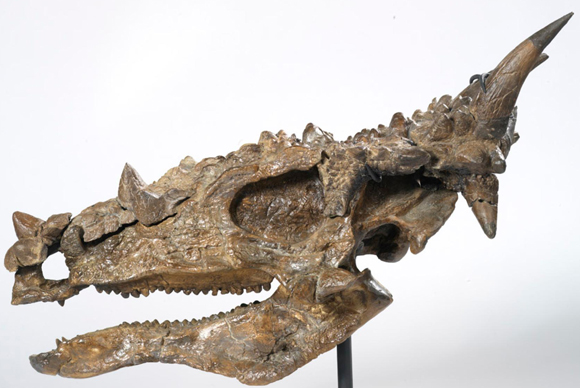
Picture credit: Brian Boyle (Royal Ontario Museum)
Front Portion of the Jaws Suggests Omnivory in Certain Pachycephalosaurs
In a presentation made at the annual meeting of the Society of Vertebrate Palaeontology held in Albuquerque, New Mexico, Mark Goodwin (University of California Museum of Palaeontology) and David Evans (Royal Ontario Museum), described a near complete juvenile pachycephalosaur skull from eastern Montana. The back of the jaws contained the broad, leaf-shaped teeth which seem well suited to herbivory. It had been assumed that the teeth in the front of the jaws (premaxilla and the anterior portion of the dentary, immediately behind the predentary), were the same shape. However, until this fossil specimen was found, no record of the front teeth of these dinosaurs existed.
Palaeontologists may have to re-think their views on the diet of this member of the Hell Creek Formation biota. The sharp, blade-like triangular teeth located at the front of the mouth seem adapted to ripping and tearing flesh.
The Teeth at the Front of the Jaws are Typical of a Meat-eating Theropod Dinosaur
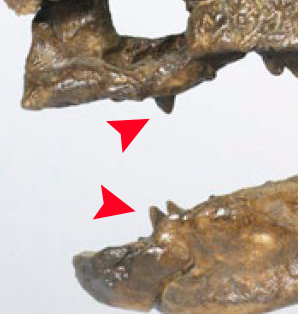
Picture credit: Brian Boyle (Royal Ontario Museum) with additional annotation by Everything Dinosaur
Confusing Pachycephalosaurs
Pachycephalosaurus is the largest member of the Pachycephalosauridae family to have been scientifically described and notwithstanding a cameo appearance of a jail-breaking Stygimoloch in the recent “Jurassic World – Fallen Kingdom” movie, perhaps the most famous. However, not a great deal is known about Pachycephalosaurus and other bone-headed dinosaurs. Fossil remains tend to be very fragmentary and most species have been named from quite scrappy remains and then you have those amazing skulls to consider.
The CollectA Pachycephalosaurus Dinosaur Model
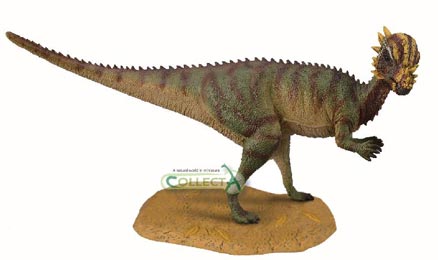
The model (above) is from the CollectA Prehistoric Life range.
To view this range: CollectA Prehistoric Life Models.
Several species have been named based on the shape and cranial ornamentation associated with those thickened skulls. The thick bone may resist erosion and provide palaeontologists with some fossil bone to study, but it has been suggested that the skulls of these dinosaurs changed dramatically as the animal grew. So much so in fact, that a number of academics, including Mark Goodwin, have published scientific papers that cast doubt on the validity of many pachycephalosaur species. For example, palaeontologists such as Goodwin have put forward evidence to suggest that both Dracorex and Stygimoloch are not distinctive species, the fossils ascribed to these two genera could represent juvenile Pachycephalosaurus specimens.
It seems, just like many other types of Late Cretaceous ornithischian dinosaur, the pachycephalosaurs underwent extreme changes to the shape of their heads as they grew up. Such changes in cranial morphology have resulted in the establishment of several species that may actually just represent examples of the same species but at different growth stages.
Some Palaeontologists Suggest that Radical Changes in Skull Shape and Ornamentation Do Not Indicate Different Species but Different Growth Stages
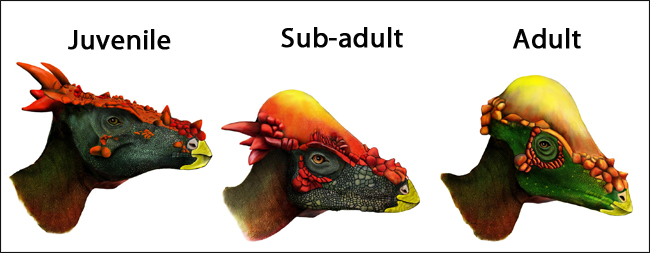
Picture credit: Kari Scannella with additional annotation by Everything Dinosaur
To complicate matters, pachycephalosaur fossil material covers a period of approximately 2 million years. Over this timescale, these animals evolved and their skull morphology changed, thus, further blurring the lines between different species and fossils of the same species but at different levels of maturation.
Confirming the Likely Diet of Pachycephalosaurus
It would be difficult to confirm that Pachycephalosaurus also ate other animals as well as plants, but not impossible. Only one jaw fossil with the front teeth in situ has been found, so scientists don’t know whether the diets of these dinosaurs changed as they grew. Perhaps, young pachycephalosaurs were omnivorous, whilst when fully grown, adults tended to consume plants rather than other animals. The rib cages of those genera which have a more complete fossil record, suggest that these bipeds had large guts, this would indicate a digestive system adapted to processing vegetation.
Professor Philip Currie (University of Alberta), who also attended the Society of Vertebrate Palaeontology meeting, has proposed that studying carbon isotopes preserved in the tooth enamel might provide further evidence relating to diet. In addition, the many hundreds of examples of isolated, broken teeth from the Hell Creek Formation could be re-examined and checked for any potential affinities with the Pachycephalosauridae. Feeding traces from fossil bone could also yield more data in support of the idea that bone-headed dinosaurs ate meat.
A Reconstruction of the Skull of an Adult Pachycephalosaurus
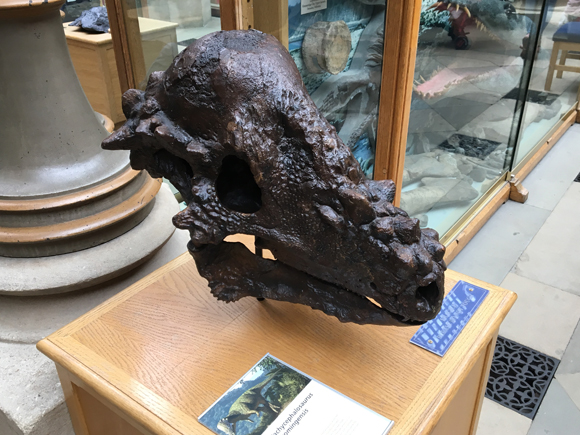
Picture credit: Everything Dinosaur
A spokesperson from Everything Dinosaur commented:
“It is likely that there are many more examples of pachycephalosaurs to be found in Upper Cretaceous rocks, hopefully, if more fossil material can be discovered, then palaeontologists will be able to piece together a more complete phylogeny of these strange dinosaurs. Furthermore, if more examples of their dentition [teeth] come to light, then we might be able to gain a better understanding of their diets. “
Visit the Everything Dinosaur website: Everything Dinosaur.

